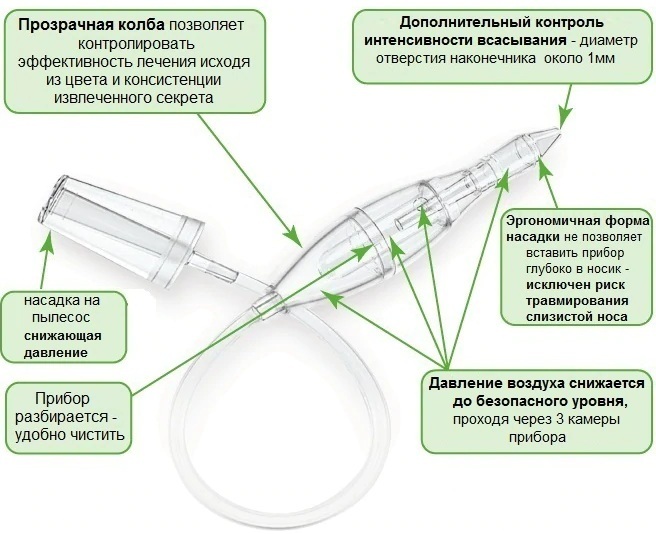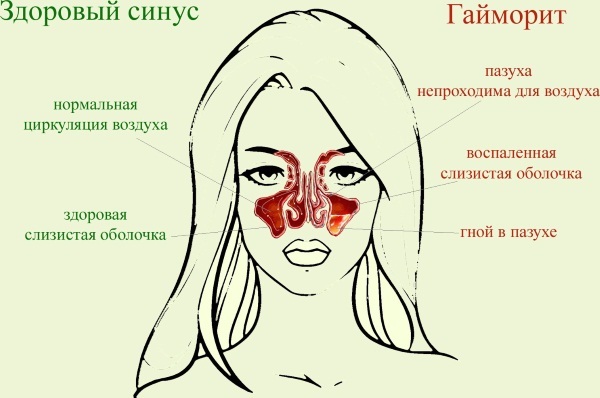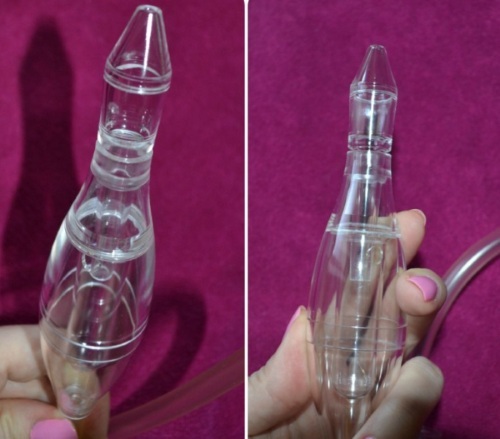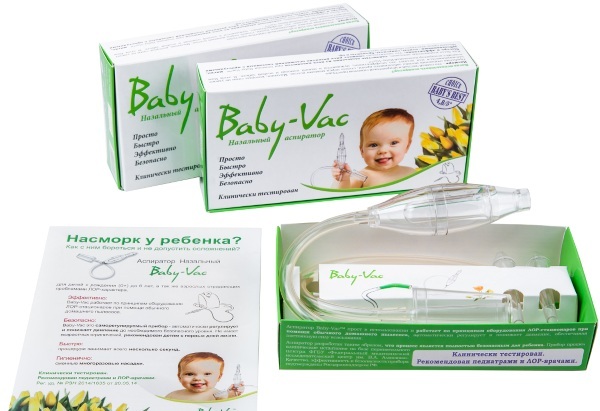Nasal aspirator Baby-Vac is a self-regulating device that makes it possible to gently and painlessly cleanse the nasal cavity from mucous secretions.
The device has no age restrictions, therefore it is used for babies from the first days after the moment of birth. The use of an aspirator allows you to quickly facilitate the breathing process, speed up recovery and prevent the development of complications.
Record content:
- 1 The composition of the Baby-Vac aspirator
- 2 Equipment
- 3 general description
- 4 Features of attachments
- 5 Indications for use
- 6 Contraindications
- 7 Side effects
- 8 Dosage
- 9 Instructions for use
- 10 Special conditions for use of the nasal aspirator
- 11 Selling features
- 12 Storage and care
- 13 Price
- 14 Video about the Baby-Vac aspirator
The composition of the Baby-Vac aspirator
Baby-Vac is an aspirator that consists of 4 parts. After use, they can be easily detached from each other, rinsed and treated with a disinfectant.
Components of the device:
- cone-shaped nozzle adapter attached to the tube of the vacuum cleaner;
- collector flask;
- flexible tube connecting the adapter nozzle and the collector flask;
- replaceable nozzle inserted into the nasal cavity.
To clean the nasal passages, a vacuum cleaner with a power regulator is required.
Equipment
The Baby-Vac nasal aspirator is enclosed in a branded packaging, sealed in plastic wrap. On the outside of the box there is a description of the device, indications and contraindications for its use are indicated.
Inside the box is the device itself, 2 replaceable nozzles for reusable use and detailed instructions for use. In addition to the device, a special brush is included for thorough cleaning of hard-to-reach areas of the device.
general description
Baby-Vac is an aspirator made of transparent impact-resistant plastic. At one end of it there is an adapter nozzle that has a conical shape for a tight connection with the vacuum cleaner tube. With the help of a flexible hollow tube, it is connected to a collector flask, on which a nozzle is put on, which is inserted directly into the nasal passage.
Due to the special shape of the collector, the aspirator automatically adjusts the pressure and the strength of the suction. This prevents damage to the anatomical structures and tissues of the nasal cavity, even in newborn babies.
Features of attachments
The adapter attachment of the Baby-Vac aspirator has a special conical shape that allows you to insert it tightly into the tube of almost any vacuum cleaner.
The shape of the removable nozzles on the collector does not allow them to be inserted deep into the nasal cavity. This prevents pain and discomfort, and also prevents damage to the cartilage of the nasal septum, blood vessels and soft tissues.
Indications for use
The Baby-Vac aspirator is used to cleanse the nasal cavity from mucous, serous and purulent exudate in children in the following cases:
- the presence of mucous discharge in infants in the first days after birth;
- lack of skills in blowing out the child;
- accumulation of mucus clots, small mechanical particles (dust), exfoliated crusts, dead cells of the mucous membrane in the nasal passages of infants;
- the presence of purulent discharge in chronic and acute diseases of the ENT organs.
The device can also be used for adults with disabilities, impaired coordination of movements and some functional disorders. It is also advisable to use it with severe nasal congestion during the period of acute manifestation of sinusitis.
Experts identify a number of diseases in which the use of the Baby-Vac aspirator is advisable. The main indications for its use are various rhinitis. However, even with some types of sinusitis, discharge from the nasal passages is observed, requiring regular removal.
Acute rhinitis is caused by pathogenic microorganisms, and can also be a consequence of influenza, diphtheria, scarlet fever and some other infectious diseases. Chronic rhinitis is provoked by unfavorable external factors, temperature extremes, high humidity, gas content in the room, as well as a sharp decrease in immunity.
The symptoms of rhinitis are:
- the outflow from the nasal cavity of serous exudate, replaced by mucopurulent secretions;

- subfebrile temperature;
- Difficulty nasal breathing;
- decreased sense of smell;
- headaches;
- sneezing;
- lacrimation;
- general weakness.
Patients with chronic rhinitis constantly complain of nasal congestion and the constant release of mucopurulent exudate, which makes breathing difficult.
Sinusitis is a prolonged purulent inflammation of the paranasal sinuses. The disease is more often the result of improper treatment of acute viral or bacterial infections. Factors such as the peculiarities of the anatomical structure of the nasal septa and a decrease in the general resistance of the organism are recorded less often.
Symptoms of sinusitis are:
- persistent nasal congestion, in which blowing your nose does not bring relief;
- severe pain in the frontal part of the face and cheekbones;
- increased body temperature;
- purulent discharge from the nasal passages;
- sensation of a smell of pus with a decrease in the general acuity of smell;
- decreased hearing acuity.

Since the frequent use of vasoconstrictor drops aggravates the situation, the use of an aspirator in combination with antibiotic therapy is the best way out.
Sphenoiditis is a pathology manifested by inflammation of the sphenoid sinus. The danger of the disease lies in the proximity of the inflammatory process to the pituitary gland, carotid artery and optic nerves.
The main symptom of sphenoiditis is constant compressive pain in the occipital region and upper part of the head, which is not relieved by conventional analgesics. Nasal discharge most often flows down the back of the nasopharynx. However, there are cases of nasal congestion in which an aspirator should be used.
Ethmoiditis is an inflammation of the ethmoid bone caused by pathogenic viruses, bacteria and fungi.
The disease manifests itself:
- one or two-sided swelling of the nasal mucosa;
- constant pain at the root of the nose;
- decreased visual acuity;
- hyperemia and edema of the periorbital region;
- an increase in body temperature indicators.
Purulent nasal discharge is not found in all cases. But if they are available, it becomes necessary to use an aspirator. Frontitis is characterized by inflammation of the frontal sinuses.
The most acute is the purulent form of this disease, in which the following symptoms are noted:
- severe pain in the forehead;
- profuse lacrimation;
- serous-purulent discharge from the nasal cavity with a pungent unpleasant odor;
- high body temperature;
- photophobia.
In severe cases, patients experience loss of consciousness.
Flushing the nasal passages in conjunction with the use of a nasal aspirator provides temporary relief until the underlying cause of the disease is resolved. To do this, it is necessary to choose the right antibacterial drugs that will affect specific representatives of pathogenic microorganisms.
Hymoroetmoiditis is most often recorded in children and is a consequence of the negative effects of staphylococci and streptococci. At first, it manifests itself as inflammation of the mucous membranes of the nasal cavity, and then gradually passes to the paranasal sinuses.
The main symptoms of maxillary ethmoiditis include:
- characteristic purulent discharge from the nose;
- severe swelling and hyperplasia of the mucous membrane, causing persistent nasal congestion;

- headaches, most often in the morning;
- significant increase in overall body temperature;
- labored breathing;
- decreased sense of smell;
- sleep disorders;
- hoarseness of voice.
The use of the Baby-Vac aspirator is a direct indication in the treatment of sinusitis in children and adults. Allergic rhinitis is often manifested by serous discharge, which can spontaneously flow out of the nasal passages.
However, in cases where the discharge becomes serous-mucous, it is advisable to talk about the use an aspirator in combination with antihistamines and nasal irrigation to reduce swelling. Allergic rhinitis can occur both seasonally and year-round, depending on the allergen.
Additional symptoms of allergic rhinitis are:
- lacrimation;
- nasal congestion;
- itching;
- violation of the respiratory rhythm;
- redness of the eyes and visible mucous membranes;
- sneezing.
Lack of treatment can provoke the development of bronchial asthma.
Rhinitis, provoked by the proliferation of adenoids, is observed in children from 3 to 10 years old. A runny nose can be observed for more than 3 weeks, followed by fading and frequent relapses. The lack of proper treatment leads to the development of bacterial pathogenic microflora on the surface of the adenoids.
In this case, the disease is accompanied by the following clinical signs:
- headaches;
- growing weakness;
- dizziness;
- persistent nasal congestion;
- decreased hearing and smelling acuity;
- soreness in the cheekbones;
- wet cough.
Timely removal of nasal secretions with an aspirator reduces the risk of complications. However, complete recovery can only be achieved with an integrated approach to treatment.
Contraindications
Despite the safety and versatility of the Baby-Vac aspirator, there are a number of contraindications to its use in children and adult patients.
These include:
- nosebleeds;
- obstruction of the nasal passages on the first day of the development of inflammation;
- benign and malignant neoplasms in the nasal cavity and nasopharynx.

Care should be taken to insert the device nozzle in case of severe swelling of the nasal mucosa.
Side effects
With strict adherence to the instructions for use, a person does not feel discomfort during the cleaning procedure. However, in the case where the suction is performed continuously for a long period of time, the patient's ears become heavily blocked. To avoid this, manufacturers recommend keeping your mouth slightly open during the procedure.
Other indirect side effects include the fright of a small child from turning on the vacuum cleaner. Therefore, it should be placed as far as possible from the baby and immediately turn on the minimum operating mode, in which the sound becomes quieter.
If there is a profuse discharge or rinsing the nose with saline, the contents of the nasal cavity can enter through the manifold into the vacuum cleaner. Manufacturers advise keeping the attachment strictly perpendicular to the floor to reduce the risk of this phenomenon.
However, according to customer reviews, thick secretions are retained in the receiving device, and liquid enters the vacuum cleaner drum through the tube. In this case, throw away the disposable dust bag or thoroughly rinse the reusable dust container with water and treat it with a disinfectant.
Dosage
Extract the contents of the nasal cavity using an aspirator should be no more than 5 seconds. If necessary, you need to take a break for 4-5 seconds and repeat the session. In this way, it is possible to alternate periods of suction with rest until new portions of exudate cease to flow into the collector.
Instructions for use
Baby-Vac is an aspirator that has very precise and detailed instructions, including several sequential operations.
Preliminary preparation:
- set the power level regulator of the device to the minimum position (if possible, turn on the silent mode of operation);
- position the vacuum cleaner at the maximum distance from the child, at which it is possible to quickly turn it on;
- connect the vacuum cleaner to the power supply.
Assembling the aspirator and preparing it for operation is carried out according to the following algorithm:
- wash all parts of the aspirator with soapy water;
- insert a replaceable reusable nozzle into the manifold;
- tightly insert the cone-shaped adapter nozzle into the vacuum cleaner tube;
- turn on the vacuum cleaner.
Next, you should choose the most comfortable position for the child. Experts recommend the following body positions, depending on the age of the baby.
| Child's age | Body position |
| 0 to 6 months | Lying so that the head is not thrown back. |
| 6 months to one and a half years | Seated or reclining |
| Older than one and a half years | Sitting on the lap of an adult, with his back pressed against his chest and stomach. |
The baby's head should be tilted slightly forward. This will prevent the rinsing solution from entering the mouth and facilitate the drainage of secretions from the nasal passages.
How to work with an aspirator:
- firmly attach the replaceable tip to one nostril of the child;
- ask the child not to close his mouth or hold his breath (babies do this intuitively);
- gently mix the nozzle up and down and left and right without removing the device from the nasal passage;
- visually make sure that discharge has begun to flow into the transparent collector;
- after 5 seconds, remove the nozzle;
- repeat the manipulation with the second nostril.
If necessary, the procedure can be repeated after 5-10 seconds, observing the same procedure and operating time.
At the end of the manipulation, the vacuum cleaner should be unplugged and the adapter attachment removed from it.
It is necessary to rinse the device after each use.
To do this, you should:
- remove the removable nozzle;
- disassemble the flask;
- disconnect the flexible tube.
Use only warm soapy water for washing. Any chemical solutions, disinfectants and abrasive substances can damage the device.
Dry the aspirator in a disassembled way in a natural way. Then it should be folded in its original packaging or in a separate box.
With severe nasal congestion, pediatricians recommend irrigating the nasal passages with a 0.9% solution of sodium chloride or sea salt before the procedure. You can also use ready-made pharmacy seawater sprays designed to relieve nasal congestion with rhinitis. This procedure will soften dried crusts and speed up exudate removal.
Special conditions for use of the nasal aspirator
Baby-Vac is an aspirator that can be used only if you have a vacuum cleaner with a built-in power regulator. The recommended minimum power is 800W and the maximum is 1800W. The best option would be the presence of a silent mode in the vacuum cleaner. This will allow the electrical appliance to be placed close to the site of the nose cleaning procedure.
If the vacuum cleaner does not have a power regulator, then it is necessary to use a special hole on the tube, with which you can adjust the air pressure.
Selling features
The Baby-Vac aspirator can be purchased over the counter in pharmacies without a doctor's prescription. The device can also be ordered from online pharmacies. In this case, you should select only verified sites, and after delivery, you must check the integrity of the packaging and the presence of a complete set.
Storage and care
On the packaging of the aspirator, manufacturers indicate the shelf life, which is 5 years. But if cracks appear during storage or operation, a change in the color or structure of the material under the influence of any external factors, then the device should be thrown away and purchased a new one.

It is forbidden to store the aspirator, on the walls of which there are traces of secretions or other contaminants. Also, do not place it near electric heaters and open flames, expose it to freezing or exposure to sunlight. The optimal temperature range for storing the device is from 5 to 40°C.
Price
In Moscow, the Baby-Vac aspirator can be purchased for 1,450 rubles. In St. Petersburg, the price will be 1500-1550 rubles. In other regions of Russia, the cost ranges from 1350 to 1600 rubles. depending on the location of the settlement.
Video about the Baby-Vac aspirator
Review of the nasal aspirator Baby-Vac:
